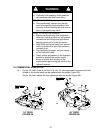
8
G0
7
09
1.6 SLOPE OPERATION
1.6.1 Use EXTREME caution when mowing and/or turning on slopes as loss of traction
and/or tip-over could occur. The operator is responsible for safe operation on slopes.
DANGER
POTENTIAL HAZARD
♦ Mowing on wet grass or steep slopes can
cause sliding and loss of control.
WHAT CAN HAPPEN
♦ Wheels dropping over edges, ditches,
steep banks, or water can cause
rollovers, which may result in serious
injury, death or drowning.
HOW TO AVOID THE HAZARD
♦ Do not mow slopes when grass is wet.
♦ Do not mow near drop-offs or near water.
♦ Do not mow slopes greater than 15
degrees.
♦ Reduce speed and use extreme caution
on slopes.
♦ Avoid sudden turns or rapid speed
changes.
1.6.2 See inside the back cover to determine the approximate slope angle of the area to be
mowed.
1.6.3 Use a walk behind mower and/or a hand trimmer near drop-offs, ditches, steep banks or
water. This area can be dangerous, see Figure 1.
FIGURE 1
1.6.4 Progressively greater care is needed as the slope increases.
1.6.5 Do not try to stabilize the machine by putting your foot on the ground.
1.6.6 Always avoid sudden starting or stopping on a slope. If tires lose traction, disengage
the blades and proceed slowly down the slope.
1.6.7 Avoid sudden starts when mowing uphill. Mower may tip backwards.
1.6.8 Be aware that loss of traction may occur going downhill. Weight transfer to the front
wheels may cause drive wheels to slip and cause loss of braking and steering.
1.6.9 Watch for ditches, holes, rocks, dips, and rises that change the operating angle, as
rough terrain could overturn the machine. Tall grass can hide obstacles.
1.6.10 Remove or mark obstacles such as rocks, tree limbs, etc. from the mowing area. Tall
grass can hide obstacles.
1.6.11 Use extreme care with grass catchers or attachments. These can change the stability
of the machine and cause loss of control.


















